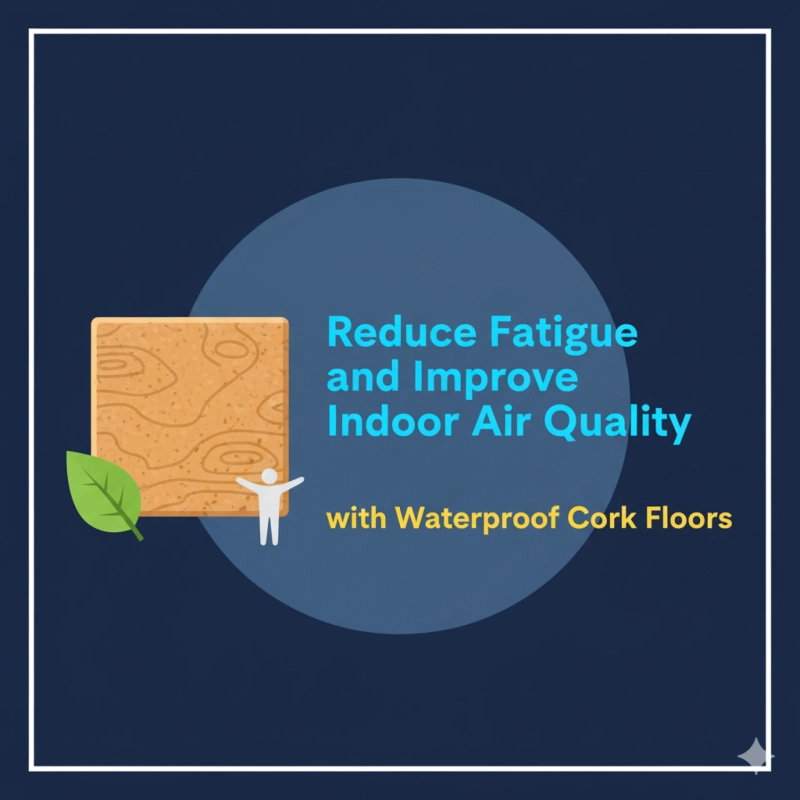Key Takeaways
- Cork flooring reduces fatigue and supports joint health.
- It improves indoor air quality thanks to low VOC emissions and hypoallergenic properties.
- Modern waterproof cork flooring expands cork’s potential into kitchens, bathrooms, and more.
- Duro Design Cork Flooring combines beauty, performance, and eco-friendliness.
- Cork is easy to clean, quiet, insulating, and long-lasting.
- You don’t have to compromise between comfort, sustainability, and design.
When you’re standing for hours in a kitchen, office, or studio, the type of flooring underfoot matters more than you might expect. Hard surfaces can wear you down, both physically and mentally. And if you’re also concerned about allergies, off-gassing, or overall indoor air quality, the decision becomes even more important.
That’s where cork flooring—especially waterproof options like Wicanders Cork Flooring—offers a standout solution. It's soft, resilient, and doesn’t just look great—it also contributes to a healthier, more comfortable home or workspace.
The Problem with Most Floors
Hard surfaces like tile, laminate, or concrete might be durable, but they come with downsides:
- They’re tough on joints. Extended time standing on these surfaces can lead to fatigue, soreness, and discomfort.
- They can be cold and noisy. No insulation means temperature fluctuations and echo chambers.
- They often contribute to poor indoor air quality. Many conventional floors emit VOCs or trap dust and allergens.
If you’re looking for comfort and wellness, especially in areas where moisture is a factor, traditional flooring might be holding you back.
Why Cork Flooring is Different
Cork is not your average material. It’s harvested sustainably from cork oak trees, and its unique structure—millions of tiny air-filled cells—gives it natural flexibility, insulation, and softness.
Here’s what makes cork stand out:
- Soft and supportive: It cushions your feet and joints, reducing physical fatigue.
- Warm underfoot: Cork naturally insulates against cold.
- Quiet: It absorbs sound, so spaces feel calm and peaceful.
- Naturally hypoallergenic: It resists mold, mildew, and dust.
- Low VOC: Quality cork flooring like Duro Design’s is manufactured with low-emission adhesives and finishes.
These features make cork a smart choice for anyone prioritizing comfort, sustainability, and indoor air quality.
Is Cork Flooring Waterproof?
Traditionally, cork has been water-resistant, but not fully waterproof. That’s changed.
Engineered waterproof cork flooring uses advanced finishes and click-lock systems to seal out moisture. This makes it suitable for kitchens, bathrooms, laundry rooms, and even basements.
Duro Design Cork Flooring offers:
- Factory-applied, ultra-durable finishes
- Floating or glue-down installations
- Moisture-resistant construction
- Compatibility with radiant floor heating
You can install cork flooring in places you never could before—all without sacrificing the benefits of comfort and air quality.
Healthier Homes Start with Better Materials
We breathe in more indoor air than outdoor air. So what’s in your home matters. Many flooring materials off-gas for months—or even years—after installation. That can contribute to headaches, asthma, and other health issues.
Cork avoids many of these problems:
- It’s naturally antimicrobial.
- It doesn’t trap allergens like carpet.
- Duro Design’s adhesives and finishes are low in VOCs.
For families with kids, pets, or anyone with allergies or sensitivities, cork offers peace of mind.
Indoor air quality is one of those invisible factors that affects how we feel every day. Subpar materials might not show their effects immediately, but over time, the air quality in your home can impact energy levels, immune response, and long-term wellness. Flooring plays a big role because of its surface area, potential for off-gassing, and contact with moisture.
Cork’s resistance to mold and mildew is also significant. These are common problems in homes, especially in basements, bathrooms, and kitchens. The wrong flooring choice can become a breeding ground for spores that then spread through HVAC systems. Waterproof cork flooring offers an effective defense against this, helping to keep your indoor air safer and cleaner.
Fatigue Reduction You Can Feel
If you spend hours in the kitchen, at a standing desk, or walking around your home, you’ll feel the difference cork makes.
Standing on cork feels more like standing on a yoga mat than tile. Its slight give helps absorb shock, taking pressure off your knees, hips, and lower back. That’s not just marketing—it’s something your body notices.
Over time, that reduced strain means:
- Fewer aches and pains
- Better posture
- Less end-of-day exhaustion
Many people notice the change immediately. Those who switch from tile or vinyl to cork often describe a noticeable reduction in leg and back pain. This makes cork an excellent choice for elderly residents, people with joint issues, or anyone looking to make their home more ergonomic.
The softness doesn’t mean it’s fragile. Cork flooring holds up well to regular foot traffic and offers a durable surface that won’t collapse under pressure. The key is choosing a high-quality brand like Duro Design, which offers finishes that enhance longevity while preserving the comfort cork is known for.
Style Without Compromise
You don’t have to choose between form and function. Duro Design Cork Flooring offers over 100 colors and six patterns. Whether you want a modern aesthetic, something earthy, or bold statement flooring, cork has options.
Pair that with its durability and waterproof features, and you get a floor that works hard and looks great.
Design flexibility is one of cork’s hidden strengths. You can find styles that mimic hardwood, concrete, or even stone, while still benefiting from cork’s cushioning and eco-friendly features. You can match your floor to virtually any decor scheme—from Scandinavian minimalism to rustic farmhouse to contemporary loft.
And if you're renovating a home or designing for resale, having a stylish floor that also offers health and comfort benefits can be a powerful selling point. It shows that you’ve considered not just how the space looks, but how it supports quality of life.
Installation and Maintenance Tips
Installing waterproof cork flooring is straightforward, especially with click-lock systems. Here are a few tips:
- Prep the subfloor: Make sure it’s dry and level.
- Use a vapor barrier in moisture-prone areas.
- Leave expansion gaps at walls.
- Clean up spills promptly—don’t leave standing water.
- Use furniture pads to protect the surface.
Cork floors are low-maintenance. Routine sweeping and occasional damp mopping are usually enough. For long-term care, recoat as needed with the manufacturer’s recommended finish.
If you're doing a DIY installation, floating cork planks with built-in locking systems make it relatively easy. For areas that may experience more consistent moisture exposure, consider professional installation to ensure the right underlayment and sealing practices are used.
When it comes to cleaning, avoid harsh chemicals. Use pH-neutral cleaners or products specifically designed for cork floors. This will help preserve the finish and ensure your floor
continues to look good and perform well for years to come.
Real-Life Scenarios
Kitchens: Waterproof cork provides a soft, warm surface that reduces leg strain and stands up to splashes. With its easy cleanup and antimicrobial properties, it’s a hygienic choice for food prep areas.
Home offices: If you’re using a standing desk or pacing during calls, cork flooring supports comfort and energy throughout the workday.
Basements: Traditionally tricky to finish due to moisture, basements benefit from cork’s insulation, sound dampening, and now, its waterproof versions.
Kid’s rooms: Soft, safe, and hypoallergenic, cork is a smart choice for spaces where children crawl, play, or nap on the floor.
Yoga studios or home gyms: Cork absorbs sound, adds cushioning, and stays warm, making it an ideal flooring for wellness spaces.
Retail or commercial spaces: Where employees stand all day, cork reduces fatigue and enhances the experience for customers.
Here’s your table rewritten as natural, structured content sections — ideal for blogs, product pages, or SEO-friendly copy:
Cork Flooring vs. Other Flooring Types
If you’re wondering how cork compares to other popular flooring materials, here’s a breakdown of what makes it unique.
Comfort
Cork flooring offers exceptional comfort thanks to its soft, cushioned surface that’s gentle on joints and feet.
By contrast, tile or stone floors are hard and cold, laminate and vinyl provide moderate comfort, and carpet also scores high but requires more upkeep.
Water Resistance
Modern engineered cork flooring is waterproof, making it suitable for kitchens and even some bathrooms.
Tile and stone are naturally waterproof, laminate and vinyl also resist water well, but carpet does not — it retains moisture and can lead to mold or odor issues.
VOC Emissions
Cork, particularly brands like Duro Design, has low VOC emissions, promoting healthier indoor air quality.
Tile and stone vary depending on adhesives and sealants used, while laminate and vinyl often emit medium to high VOCs. Carpet can also release similar levels due to chemical treatments and synthetic fibers.
Allergy-Friendliness
For allergy sufferers, cork is a standout choice — it resists mold, mildew, and dust mites naturally.
Tile and stone are also safe choices, while laminate and vinyl perform fairly well. Carpet, however, tends to trap dust, dander, and allergens, making it less suitable for allergy-sensitive homes.
Thermal Insulation
Cork has excellent thermal insulation, staying warm underfoot and helping maintain comfortable indoor temperatures.
In contrast, tile and stone feel cold, laminate and vinyl have poor insulation, while carpet provides good warmth but can wear unevenly over time.
Acoustic Dampening
Cork is naturally sound-absorbent, providing excellent acoustic dampening — ideal for multi-story homes or apartments.
Tile and stone reflect sound and are poor in acoustics, laminate and vinyl offer limited sound absorption, and carpet performs moderately well.
Maintenance
Cork flooring is easy to maintain — regular sweeping and occasional damp mopping are usually enough.
Tile and stone need medium effort due to grout lines, laminate and vinyl are also low-maintenance, while carpet demands frequent vacuuming and deep cleaning.
Eco-Friendliness
Cork stands out as an eco-friendly, renewable, and sustainable choice since it’s harvested from the bark of cork oak trees without harming them.
In comparison, tile, stone, laminate, and carpet are not sustainable options — they rely on non-renewable materials and energy-intensive manufacturing processes.
Final Takeaway
This comparison shows that cork flooring checks many of the boxes that matter most for health-conscious and comfort-seeking homeowners — offering a rare blend of softness, warmth, quietness, and sustainability.
Ready to Make the Switch?
If you want floors that feel better, look better, and support a healthier home environment, it’s time to consider cork.
Explore Duro Design Cork Flooring to see your color and pattern options.
Need help choosing the right fit? We’re here to help you find flooring that meets your needs—comfortably and sustainably.
Whether you’re renovating your kitchen, designing a wellness-focused home office, or building a healthier environment for your family, cork flooring gives you a smart, stylish, and sustainable foundation.


